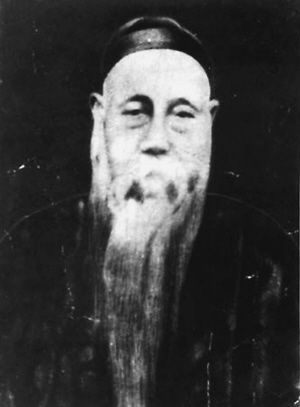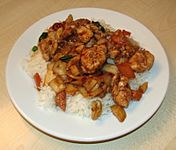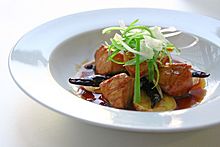Kung Pao chicken facts for kids

A Sichuan version of Kung Pao chicken
|
|
| Type | Stir-fry |
|---|---|
| Course | Main |
| Place of origin | China |
| Region or state | Sichuan |
| Associated national cuisine | Sichuan cuisine |
| Invented | Mid-to-late 19th century |
| Serving temperature | Hot |
| Main ingredients | Cubed boneless chicken, chili peppers, peanuts |
| Variations | Guizhou, Anhui, American |
| Kung Pao chicken | |||||||||||||||||
|---|---|---|---|---|---|---|---|---|---|---|---|---|---|---|---|---|---|
| Traditional Chinese | 宮保雞丁 | ||||||||||||||||
| Simplified Chinese | 宫保鸡丁 | ||||||||||||||||
| Literal meaning | Palace Guardian chicken cubes | ||||||||||||||||
|
|||||||||||||||||
Kung Pao chicken (Chinese: 宫保鸡丁; pinyin: Gōngbǎo jīdīng; Wade–Giles: Kung¹-pao³ Chi¹-ting¹), also called Gong Bao or Kung Po, is a super popular and tasty Chinese dish. It's a stir-fry made with small pieces of chicken, crunchy peanuts, some vegetables (usually Welsh onion), and spicy chili peppers.
This classic dish comes from the Sichuan province in southwestern China. Sichuan is famous for its bold and spicy Sichuan cuisine. The original Sichuan version of Kung Pao chicken often includes special Sichuan peppercorns. These give it a unique tingly feeling! While you can find this dish all over China, different regions have their own versions. These are usually less spicy than the Sichuan one. Kung Pao chicken is also a favorite in Chinese restaurants in Western countries.
Contents
History of Kung Pao Chicken

This delicious dish is believed to be named after a real person! His name was Ding Baozhen (1820–1886). He was an important government official during the late Qing dynasty in China. He even served as a governor of Sichuan Province.
His special title was Taizi Shaobao, which was part of a bigger title called Gongbao (Chinese: 宫保; pinyin: Gōngbǎo; Wade–Giles: Kung1-pao3; literally "Palace Guardian"). So, the name Kung Pao chicken comes from his title. The Chinese character 丁 (dīng) in the dish's name is also a clever play on his last name, Dīng. This character can also mean "small cube," which is perfect because the chicken is cut into small cubes for the dish!
During a time in China called the Cultural Revolution, some old names were changed. This was because they were linked to the old imperial system. So, the dish was temporarily renamed "spicy chicken" (Chinese: 糊辣鸡丁; pinyin: húlà jīdīng). But in the 1980s, under new reforms, the dish got its original name, Kung Pao chicken, back.
Different Ways to Make Kung Pao Chicken
Sichuan Style
The original Sichuan version uses chicken as its main ingredient. The chicken pieces are usually mixed with a special sauce before cooking. Shaoxing wine is often added to this sauce to make the flavor even better.
First, chili peppers and Sichuan peppercorns are quickly fried in a hot pan called a wok. This makes the oil smell wonderful. In Sichuan, or when making Sichuan-style Kung Pao chicken, only special Sichuan chili peppers are used. These include "facing heaven pepper" or "seven stars pepper" (Chinese: 七星椒; pinyin: qīxīngjiāo). Smaller, thinner Sichuan peppers might also be used.
Then, Sichuan peppercorns are added. While Kung Pao chicken isn't meant to be super numbing, a small amount of fresh, toasted peppercorns helps balance the heat from the chilis. After that, the chicken is stir-fried. Finally, chopped leeks and peanuts are added. For the best taste, fresh, unroasted peanuts are often used. These are fried in the hot oil until they turn golden brown before the other ingredients go in.
You can also find variations that use other meats instead of chicken. For example, there's "Kung Pao shrimp" (Chinese: 宫保虾) and "Kung Pao frog legs" (Chinese: 宫保田鸡).
Guizhou Style
The province of Guizhou, which is southeast of Sichuan, has its own version of Kung Pao chicken. This one uses a special fermented chili paste called ciba (Chinese: 糍粑辣椒 cíbā làjiāo).
Like the Sichuan version, the Guizhou dish uses marinated chicken cubes. However, the chicken pieces are usually larger and often still have the skin on. A big difference is how the chili is used. Instead of flash-frying whole peppers, a lot of the ciba chili paste is fried in the wok. This makes the oil turn a rich color. Then, the chicken is stir-fried in this flavorful sauce with garlic, ginger, and green garlic or green onion.
Western Style
In Western countries, you'll find versions of Kung Pao chicken that are often called Kung Po or simply chicken chili and garlic. These versions usually have diced, marinated chicken stir-fried with ingredients like orange or orange juice, ginger, garlic, chicken broth, sugar, and corn starch. Salt and pepper are added for taste.
Many other vegetables might be added to these Western versions. These can include onion, bell pepper, or carrots. The dish often includes or is topped with whole roasted peanuts. Sometimes, instead of chicken, Western variations might use other meats like pork, duck, fish, or even tofu.
-
Westernized version of Kung Pao chicken gaifan, served in London
-
A plate of homestyle Kung Pao chicken in Fresno, California.
See also
 In Spanish: Pollo Kung Pao para niños
In Spanish: Pollo Kung Pao para niños





